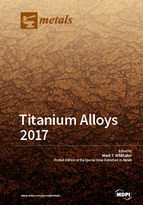Titanium Alloys 2017
A special issue of Metals (ISSN 2075-4701).
Deadline for manuscript submissions: closed (30 June 2017) | Viewed by 68029
Special Issue Editor
Interests: fatigue; creep; thermo-mechanical fatigue (TMF); superalloys; lifing; nickel alloys; titanium alloys
Special Issues, Collections and Topics in MDPI journals
Special Issue Information
Dear Colleagues,
Although titanium was originally discovered in the 18th century, significant developments in the titanium industry only occurred in the middle of the 20th century. These changes resulted from the emergence of the gas turbine engine. Since that time, the aerospace sector has dominated worldwide titanium use; the metal has applications in both engines and airframe structures. Titanium has a highly desirable combination of properties: these include excellent corrosion resistance, a high strength to weight ratio, and good fatigue resistance. Such qualities enable extensive applications; only high extraction and processing costs restrict further implementation.
Although the aerospace industry faces challenges related to increasing operating temperatures and the development of polymer based composites, innovative solutions, including metal matrix composites and titanium aluminides, provide pathways for future development. Furthermore, improvements in extractive metallurgy and processing methods have made titanium-based alloys more accessible to alternative industries. Industries currently utilizing these materials include the sports, biomedical, and marine sectors.
As more traditional applications are supplemented by exciting new opportunities, it is clear that extensive research opportunities are likely to exist in the titanium industry for the foreseeable future.
Dr. Mark T. Whittaker
Guest Editor
Manuscript Submission Information
Manuscripts should be submitted online at www.mdpi.com by registering and logging in to this website. Once you are registered, click here to go to the submission form. Manuscripts can be submitted until the deadline. All submissions that pass pre-check are peer-reviewed. Accepted papers will be published continuously in the journal (as soon as accepted) and will be listed together on the special issue website. Research articles, review articles as well as short communications are invited. For planned papers, a title and short abstract (about 100 words) can be sent to the Editorial Office for announcement on this website.
Submitted manuscripts should not have been published previously, nor be under consideration for publication elsewhere (except conference proceedings papers). All manuscripts are thoroughly refereed through a single-blind peer-review process. A guide for authors and other relevant information for submission of manuscripts is available on the Instructions for Authors page. Metals is an international peer-reviewed open access monthly journal published by MDPI.
Please visit the Instructions for Authors page before submitting a manuscript. The Article Processing Charge (APC) for publication in this open access journal is 2600 CHF (Swiss Francs). Submitted papers should be well formatted and use good English. Authors may use MDPI's English editing service prior to publication or during author revisions.
Keywords
- extractive metallurgy processing
- microstructure evolution
- properties
- intermetallics
- MMCs
- aerospace
- biomedical






